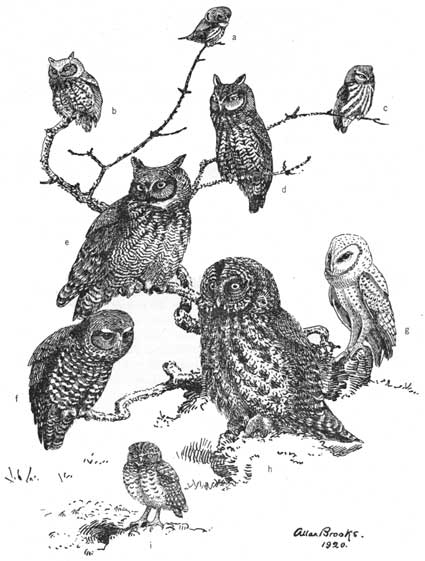|
Animal Life in the Yosemite
|

|
|
THE BIRDS BARN OWL. Tyto pratincola (Bonaparte) Field characters.—Medium size for an owl (length 15 or more inches, spread of wings about 45 inches); no ear tufts (fig. 39g); eyes relatively small, dark-colored (not yellow). General color of plumage above light golden brown; under surface white or buffy white; face white, heart-shaped, bordered by a rim of brownish feathers. Voice: A single prolonged rasping screech, sksch or ksch ----; also a rapid clicking noise, click; click, click, etc. Occurrence.—Common resident wherever appropriate daytime shelter is afforded in the lowlands (Lower Sonoran Zone chiefly). Observed by us only at Snelling and west of Pleasant Valley. The Barn Owl, as its name might indicate, has become so well adapted to the presence of man that when unmolested it takes up its quarters in a barn, attic, or windmill tower, sleeping quietly by day and issuing forth at dusk to hunt in the neighboring fields for mice and gophers. Its usefulness in this connection is well recognized and can be readily corroborated through an examination of the large collection of pellets found under any long-occupied roost. The Barn Owl usually begins its nightly forays at late dusk and can be seen at that time, sweeping out over the fields in search of prey. One of these birds was seen abroad on a small plateau west of Pleasant Valley on the cloudy and rainy morning of February 26, 1916. The bird was on the ground near a squirrel hole in a pasture, and probably was on the watch for prey. This owl, if aroused during the daytime, shows itself able to see well, even in strong sunlight, and will fly quickly and unhesitatingly to another retreat. Its flight, like that of owls in general, is exceedingly quiet, evidently due to the very soft quality of its plumage. The notes of the Barn Owl are of two kinds: One is a single, loud, prolonged, rasping sksch, uttered only at long intervals; the other, a series of notes click, click, click, click, click, resembling in character the notes of a katydid, but delivered with diminishing emphasis and shortening intervals toward the end of the series. From the changing direction of the sounds, it is evident that the notes are uttered in flight as one bird closely follows another. Sometimes a second bird will start his (or her) series of clicks before the first has finished. The distinctive outline of the Barn Owl's face has given rise in many places to the name Monkey-faced Owl, and the peculiar color of plumage to the name Golden Owl.
|
| <<< PREVIOUS | CONTENTS | NEXT >>> |
Animal Life in the Yosemite ©1924, University of California Press Museum of Vertebrate Zoology grinnell/birds50.htm — 19-Jan-2006 | ||
